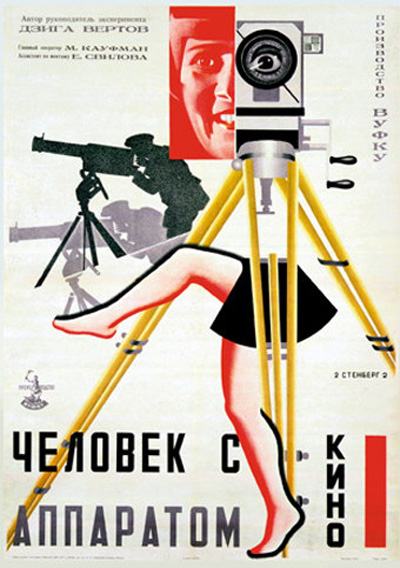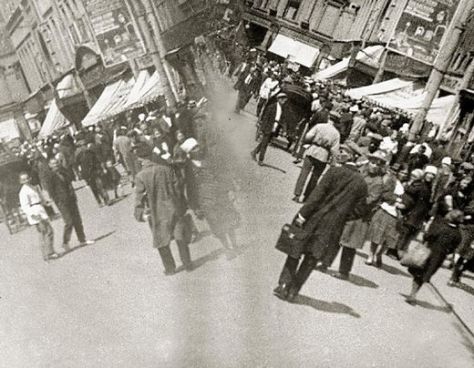
As of next week, Man With a Movie Camera could be coming to a big screen, or a Blu-ray machine, near you. And there’s always a good reason to watch Man With a Movie Camera again. First, because it’s such a stunning film: exhilarating, avant-garde and witty. And second, because each time you do, you’ll grapple with the questions it throws at you again – and just possibly come up with different conclusions. This magnificent movie may be a film studies set text, but it defies attempts at explanation, and in fact, it has a unique way of wriggling out of any category you might try to impose on it. Recently crowned top documentary of all time, it is also an experimental art film. It appears to be a City Symphony but it is a fraudulent one – filmed in three cities and naming none of them. Its absurdities of composition and action make the audience think of comedy, even cartoons and its trick cuts and frame manipulation are closer to animation than conventional film-making.
If I could rechristen this film as its director did himself when he went from plain David Kaufman to the far more evocative Dziga Vertov, I would call it Woman with a Moviola. The new name would be in honour of Yelizaveta Svilova, who edited the film with Vertov, and whom we see stitching together frames midway through the film. The man of the title clambers, and tilts and gets where the action is, that’s for sure, as any camera operator should do. But the magic of this film is in its elaborate construction, its celebration of those arts that are purely cinematic – not offcuts from other media. As Roger Ebert said when he reviewed the film in 2009: “It’s what you do after you have your frames that makes it cinema.”

The Council of Three intended, as the film asserts in its opening titles, to create “a truly international language of cinema based on its absolute separation from the language of theatre and literature”. And that is why Man With a Movie Camera has no story or characters, beyond the notional idea that the man is filming and the woman editing, and the vaguest of settings. Everything it has to say is about the cinema, and expressed in the language of film. Novelty and speed are the dominant modes. Scenes of city life multiply, running backwards and forwards, sliced in half, doubled, superimposed with yet more busyness or shot from stark, lonely angles. This “excerpt from the diary of a cameraman” begins in the cinema, the projector sparking into life, the seats flapping open, and ends there too, the audience entranced by the high-speed antics of the cameraman on screen. But by this point, the camera has learned to operate itself, attaching itself to a tripod and slinking off to shoot more scenes in a cinematic language of the future: a vital new artform both animated and liberated.
And at the film’s tumultuous climax, a sharply effective, and rightly famous, double exposure creates a camera-eye and disconcerting double entendre. Has the machine become human or the human machine? “I am the camera eye, I am the mechanical eye,” said Vertov. “I am the machine which shows you the world as only I can see it.” It’s a famous statement of auteurist authority, but attached to a film that appears to cast off such old-fashioned notions. It’s as if the technology, not the director, is calling the shots.

Blink, and you will miss everything. Even if you don’t blink, I stand by my assertion that this is a film worth watching and rewatching. Which brings me to the two options that face you at the end of July. On extended run at the BFI Southbank, and at selected cinemas nationwide, you can see a pinsharp new digital restoration of the film, with a triumphant soundtrack by Alloy Orchestra, incorporating cues from Vertov himself. It’s a brilliant package – the most physically intense, almost overpowering, experience I have had watching this movie. You may have heard this score before, it’s been around for a while, and with good reason. Alloy Orchestra’s music clatters and bangs as often as it is whirlingly, catchily, tuneful. It incorporates a clutch of sound effects with good humour and clearly intends to provide the aural equivalent of whistlestop montage. I hugely enjoyed it, and I’m going to call that Plan A.
Plan B is none-too-shabby, though. The BFI is also reissuing Man With a Movie Camera on Blu-ray. Bafflingly, this is not the same restoration as the cinema release. It’s a little murkier all round, but still more than impressive for a 1929 film. The Alloy Orchestra are absent too – the soundtrack on offer here is another old favourite, by Michael Nyman. This score comprises music from previous works by Nyman, re-arranged for the film. Purposefully, Nyman did not consult Vertov’s notes on his musical requirements, and yet, his score feels more reverent, less cheeky. And that sets the tone for this Blu-ray package: this is for those who wish to consider the film at their leisure, whereas the cinema release offers more immediate thrills. The Blu-ray is well stocked, as you’d expect: there’s an audio commentary, by Yuri Tsivian, a booklet of essays and three more Vertov films. Those titles are the “poetic propaganda” film Three Songs of Lenin, and two hardcore Soviet documentaries Kino Pravda No 21, a paean to Lenin, and the documentary One-Sixth of the Globe, which explores the remotest parts of the Soviet Empire. Be warned if you are of a delicate disposition, though, that all the extra films come with musique concrete soundtracks by Mordant Music that are anything but easy listening. The score for Kino Pravda No 21, for example, appears to run the full gamut of sounds from “malfunctioning modem” to “bee in a jamjar”. Plan B is for the head-scratchers, and if you have read all the way to the end of this review, that’s probably you.
- Man With a Movie Camera with the Alloy Orchestra score is on extended run at BFI Southbank and in cinemas nationwide from 31 July
- Man With a Movie Camera screens with the recorded Michael Nyman score on 16 August at the Regent Street Cinema
- Man With a Movie Camera is released on Blu-ray by the BFI on 27 July, priced £19.99
You’re on fire with the posts lately, Pam! I love Man With a Movie Camera – just fantastic. One of those canonical films that 100% lives up to its reputation. Svilova was a huge talent, because the film really stands on its editing. Have you seen Mikhail Kaufman’s In Spring, by the way? It’s a beautiful film.
I love the sound of those musique concrète scores. If I ever gain BluRay player, I’ll definitely need a copy of this.
Ha, thanks! I must be warming up for Pordenone. Have only seen snatches of In Spring I am afraid. Another one to bump up the list.
I am glad to see that this post gives proper credit to the members of the Factory of Facts collective; to treat the film as the work of an auteur, Vertov, is to misunderstand the work of these pioneer cineastes.
As for the bfi blu-ray re-issue; well the proper way to see this film is in the cinema, which is what we see at the opening of the film itself. It would also be nice if some enterprising exhibitors treated us to a 35mm screening: I assume the bfi digital is at 2k – inadequate for this film, as for many other great movies.
You’re right about the cinema, Keith and also that this is a 2k restoration. it does look good, though.